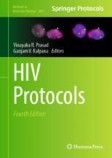Search
Search Results
-
Acute Administration of HIV-1 Tat Protein Drives Glutamatergic Alterations in a Rodent Model of HIV-Associated Neurocognitive Disorders
HIV-1-associated neurocognitive disorders (HAND) are a major comorbidity of HIV-1 infection, marked by impairment of executive function varying in...

-
Impact of subtype C-specific amino acid variants on HIV-1 Tat-TAR interaction: insights from molecular modelling and dynamics
BackgroundHIV-1 produces Tat, a crucial protein for transcription, viral replication, and CNS neurotoxicity. Tat interacts with TAR, enhancing HIV...

-
NRF2 Antagonizes HIV-1 Tat and Methamphetamine-Induced BV2 Cell Ferroptosis by Regulating SLC7A11
Methamphetamine (METH) and HIV-1 lead to oxidative stress and their combined effect increases the risk of HIV-associated neurocognitive disorder...

-
Fentanyl dysregulates neuroinflammation and disrupts blood-brain barrier integrity in HIV-1 Tat transgenic mice
Opioid overdose deaths have dramatically increased by 781% from 1999 to 2021. In the setting of HIV, opioid drug abuse exacerbates neurotoxic effects...

-
Caffeine upregulates SIRT3 expression to ameliorate astrocytes-mediated HIV-1 Tat neurotoxicity via suppression of EGR1 signaling pathway
Caffeine is one of the most popular consumed psychostimulants that mitigates several neurodegenerative diseases. Nevertheless, the roles and...

-
Endolysosome iron restricts Tat-mediated HIV-1 LTR transactivation by increasing HIV-1 Tat oligomerization and β-catenin expression
HIV-1 transactivator of transcription (Tat) protein is required for HIV-1 replication, and it has been implicated in the pathogenesis of...

-
Myelin regulatory factor is a target of individual and interactive effects of HIV-1 Tat and morphine in the striatum and pre-frontal cortex
HIV-associated neurocognitive disorders (HAND) remain pervasive even with increased efficacy/use of antiretroviral therapies. Opioid use/abuse among...

-
Disruption of the ADAM17/NF-κB feedback loop in astrocytes ameliorates HIV-1 Tat-induced inflammatory response and neuronal death
A disintegrin and metalloproteinases (ADAMs) are involved in multiple neurodegenerative diseases. However, the roles and mechanisms of ADAMs in...

-
HIV-1 subtype B Tat enhances NOTCH3 signaling in astrocytes to mediate oxidative stress, inflammatory response, and neuronal apoptosis
NOTCH receptors are relevant to multiple neurodegenerative diseases. However, the roles and mechanisms of NOTCH receptors in HIV-associated...

-
HIV-1 Tat drives the Fabp4/NF-κB feedback loop in microglia to mediate inflammatory response and neuronal apoptosis
Fatty acid-binding proteins (FABPs) are relevant to multiple neurodegenerative diseases. However, the roles and mechanisms of FABPs in HIV-associated...

-
Suppression of HIV-TAT and cocaine-induced neurotoxicity and inflammation by cell penetrable itaconate esters
HIV-associated neurological disorder (HAND) is a serious complication of HIV infection marked by neurotoxicity induced by viral proteins like Tat....

-
Biochemical Detection of Capsid in the Nucleus During HIV-1 Infection
Recent evidence has shown that uncoating and reverse transcription precede nuclear import. These recent breakthroughs have been made possible through...
-
Role of Dysregulated Autophagy in HIV Tat, Cocaine, and cART Mediated NLRP3 Activation in Microglia
Despite the ability of combination antiretroviral therapy (cART) to suppress viremia, there is persistence low levels of HIV proteins such as...

-
Detection of CPSF6 in Biomolecular Condensates as a Reporter of HIV-1 Nuclear Import
The initial stages of HIV-1 infection involve the transport of the viral core into the nuclear compartment. The presence of the HIV-1 core in the...
-
Expression of Human Immunodeficiency Virus Transactivator of Transcription (HIV-Tat1-86) Protein Alters Nociceptive Processing that is Sensitive to Anti-Oxidant and Anti-Inflammatory Interventions
AbstractDespite the success of combined antiretroviral therapy (cART) in reducing viral load, a substantial portion of Human Immunodeficiency Virus...

-
Vpr driving DNA methylation variation of CD4 + T cells in HIV-1 infection
BackgroundDespite the existence of available therapeutic interventions for HIV-1, this virus remains a significant global threat, leading to...

-
New insights into pathogenesis point to HIV-1 Tat as a key vaccine target
Despite over 30 years of enormous effort and progress in the field, no preventative and/or therapeutic vaccines against human immunodeficiency virus...

-
DDX5 potentiates HIV-1 transcription as a co-factor of Tat
BackgroundHIV-1 does not encode a helicase and hijacks those of the cell for efficient replication. We and others previously showed that the DEAD box...

-
Molecular Mechanisms of HIV-1 Latency from a Chromatin and Epigenetic Perspective
Purpose of ReviewThe main obstacle to an HIV-1 cure is the reservoir of HIV-1 infected cells. While antiretroviral therapy (ART) eliminates the HIV-1...

-
HIV-1 mRNA knockdown with CRISPR/CAS9 enhances neurocognitive function
Mixed glia are infiltrated with HIV-1 virus early in the course of infection leading to the development of a persistent viral reservoir in the...

